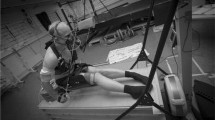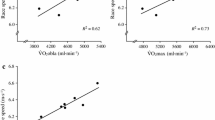Abstract
This study was designed to test the hypothesis that subjects having faster oxygen uptake (VO2) kinetics during off-transients to exercises of severe intensity would obtain the smallest decrement score during a repeated sprint test. Twelve male soccer players completed a graded test, two severe-intensity exercises, followed by 6 min of passive recovery, and a repeated sprint test, consisting of seven 30-m sprints alternating with 20 s of active recovery. The relative decrease in score during the repeated sprint test was positively correlated with time constants of the primary phase for the VO2 off-kinetics (r = 0.85; p < 0.001) and negatively correlated with the VO2 peak (r = −0.83; p < 0.001). These results strengthen the link found between VO2 kinetics and the ability to maintain sprint performance during repeated sprints.



Similar content being viewed by others
References
Allen DG, Lamb GD, Westerblad H (2008) Skeletal muscle fatigue: cellular mechanisms. Physiol Rev 88(1):287–332
Aziz AR, Chia M, Teh KC (2000) The relationship between maximal oxygen uptake and repeated sprint performance indices in field hockey and soccer players. J Sports Med Phys Fit 40:195–200
Aziz AR, Mukherjee S, Chia MY, Teh KC (2007) Relationship between measured maximal oxygen uptake and aerobic endurance performance with running repeated sprint ability in young elite soccer players. J Sports Med Phys Fit 47(4):401–407
Bailey SJ, Wilkerson DP, Dimenna FJ, Jones AM (2009) Influence of repeated sprint training on pulmonary O2 uptake and muscle deoxygenation kinetics in humans. J Appl Physiol 106(6):1875–1887
Balsom PD, Gaitanos GC, Ekblom B, Sjödin B (1994) Reduced oxygen availability during high intensity intermittent exercise impairs performance. Acta Physiol Scand 152(3):279–285
Barstow TJ, Molé PA (1991) Linear and nonlinear characteristics of oxygen uptake kinetics during heavy exercise. J Appl Physiol 71:2099–2106
Barstow TJ, Jones AM, Nguyen PH, Casaburi R (1996) Influence of muscle fiber type and pedal frequency on oxygen uptake kinetics of heavy exercise. J Appl Physiol 81(4):1642–1650
Berthoin S, Pelayo P, Lensel-Corbeil G, Robin H, Gerbeaux M (1996) Comparison of maximal aerobic speed as assessed with laboratory and field measurements in moderately trained subjects. Int J Sports Med 17(7):525–529
Berthoin S, Allender H, Baquet G, Dupont G, Matran R, Pelayo P, Robin H (2003) Plasma lactate and plasma volume recovery in adults and children following high-intensity exercises. Acta Paediatr 92:283–290
Bishop D (2003) Warm up II: performance changes following active warm up and how to structure the warm up. Sports Med 33:483–498
Bishop D, Spencer M (2004) Determinants of repeated-sprint ability in well-trained team-sport athletes and endurance-trained athletes. J Sports Med Phys Fit 44:1–7
Bishop D, Lawrence S, Spencer M (2003) Predictors of repeated-sprint ability in elite female hockey players. J Sci Med Sport 6(2):199–209
Bishop D, Edge J, Goodman C (2004) Muscle buffer capacity and aerobic fitness are associated with repeated-sprint ability in women. Eur J Appl Physiol 92:540–547
Bogdanis GC, Nevill ME, Boobis LH, Lakomy HK, Nevill AM (1995) Recovery of power output and muscle metabolites following 30 s of maximal sprint cycling in man. J Physiol 482(2):467–480
Børsheim E, Bahr R (2003) Effect of exercise intensity, duration and mode on post-exercise oxygen consumption. Sports Med 33(14):1037–1060
Casaburi R, Storer TW, Ben-Dov I, Wasserman K (1987) Effect of endurance training on possible determinants of VO2 during heavy exercise. J Appl Physiol 62(1):199–207
Castagna C, Manzi V, D’Ottavio S, Annino G, Padua E, Bishop D (2007) Relation between maximal aerobic power and the ability to repeat sprints in young basketball players. J Strength Cond Res 21:1172–1176
Cleuziou C, Perrey S, Borrani F, Lecoq AM, Candau R, Courteix D, Obert P (2004) Dynamic responses of O2 uptake at the onset and end of exercise in trained subjects. Can J Appl Physiol 28(4):630–641
Davison RR, Van Someren KA, Jones AM (2009) Physiological monitoring of the Olympic athlete. J Sports Sci, pp 1–10
Dawson B, Fitzsimons M, Ward D (1993) The relationship of repeated sprint ability to aerobic power and performance measures of anaerobic work capacity and power. Aust J Sci Med Sport 25:88–93
Dupont G, Millet GP, Guinhouya C, Berthoin S (2005) Relationship between oxygen uptake kinetics and performance in repeated running sprints. Eur J Appl Physiol 95(1):27–34
Ferguson C, Rossiter HB, Whipp BJ, Cathcart AJ, Murgatroyd SR, Ward SA (2010) Effect of recovery duration from prior exhaustive exercise on the parameters of the power-duration relationship. J Appl Physiol (in press)
Glaister M (2008) Multiple-sprint work: methodological, physiological, and experimental issues. Int J Sports Physiol Perf 3:107–112
Glaister M, Stone MH, Stewart AM, Hughes MG, Moir GL (2007) The influence of endurance training on multiple sprint cycling performance. J Strength Cond Res 21(2):606–612
Glaister M, Howatson G, Pattison JR, McInnes G (2008) The reliability and validity of fatigue measures during multiple-sprint work: an issue revisited. J Strength Cond Res 22(5):601–1597
Hagberg JM, Hickson RC, Ehsani AA, Holloszy JO (1980) Faster adjustment to and recovery from submaximal exercise in the trained state. J Appl Physiol 48(2):218–224
Hamilton AL, Nevill ME, Brooks S, Williams C (1991) Physiological responses to maximal intermittent exercise: differences between endurance-trained runners and games players. J Sports Sci 9:371–382
Harris RC, Edwards RHT, Hultman E, Nordesjo LO, Nylind B, Sahlin K (1976) The time course of phosphorylcreatine resynthesis during recovery of the quadriceps muscle in man. Pfluegers Arch 367:137–142
Haseler LJ, Hogan MC, Richardson RC (1999) Skeletal muscle phosphocreatine recovery in exercise-trained humans is dependent on O2 availability. J Appl Physiol 86:2013–2018
Iaia M, Rampinini E, Bangsbo J (2009) High-intensity training in football. Int J Sports Physiol Perf 4(3):291–306
Jones AM, Wilkerson DP, DiMenna F, Fulford J, Poole DC (2008) Muscle metabolic responses to exercise above and below the “critical power” assessed using 31P-MRS. Am J Physiol Regul Integr Comp Physiol 294(2):R585–R589
Kamber M (1992) Lactate measurements in sports medicine: comparison of measurement methods. Schweiz Ztschr Sportmed 40:77–86
Kilding AE, Winter EM, Fysh M (2006) A comparison of pulmonary oxygen uptake kinetics in middle- and long-distance runners. Int J Sports Med 27(5):419–426
Koga S, Shiojiri T, Kondo N (2005) Measuring \( \mathop {\rm{V}}\limits^{\rm{.}}\! {\rm{O}}_{\rm{2}}\) kinetics—the practicalities. In: Jones AM, Poole DC (eds) Oxygen uptake kinetics in sport, exercise and medicine. Routledge, London, pp 39–61
Koppo K, Bouckaert J, Jones AM (2004) Effects of training status and exercise intensity on phase II VO2 kinetics. Med Sci Sports Exerc 36(2):225–232
Lamarra NB, Whipp BJ, Ward SA, Wasserman K (1987) Effect of interbreath fluctuations on characterizing exercise gas exchange kinetics. J Appl Physiol 62:2003–2012
Léger L, Boucher R (1980) An indirect continuous running multistage field test: the University de Montréal track test. Can J Sport Sci 5:77–84
McCully KK, Fielding RA, Evans WJ, Leigh JS Jr, Posner JD (1993) Relationships between in vivo and in vitro measurements of metabolism in young and old human calf muscles. J Appl Physiol 75(2):813–819
McKay BR, Paterson DH, Kowalchuk JM (2009) Effect of short-term high-intensity interval training vs. continuous training on O2 uptake kinetics, muscle deoxygenation, and exercise performance. J Appl Physiol 107(1):128–138
McLaughlin JE, King GA, Howley ET Jr, Bassett DR, Ainsworth BE (2001) Validation of the COSMED K4 b2 portable metabolic system. Int J Sports Med 22:280–284
McMahon S, Jenkins D (2002) Factors affecting the rate of phosphocreatine resynthesis following intense exercise. Sports Med 32(12):761–784
McMahon S, Wenger HA (1998) The relationship between aerobic fitness and both power output and subsequent recovery during maximal intermittent exercise. J Sci Med Sport 1:219–227
Meyer RA, Brown TR, Kushmerick MJ (1985) Phosphorus nuclear magnetic resonance of fast- and slow-twitch muscle. Am J Physiol 248:C279–C287
Murias JM, Kowalchuk JM, Paterson DH (2010) Speeding of VO2 kinetics with endurance training in old and young men is associated with improved matching of local O2 delivery to muscle O2 utilization. J Appl Physiol (in press)
Nordsborg N, Mohr M, Pedersen LD, Nielsen JJ, Langberg H, Bangsbo J (2003) Muscle interstitial potassium kinetics during intense exhaustive exercise: effect of previous arm exercise. Am J Physiol Regul Integr Comp Physiol 285(1):R143–R148
Özyener F, Rossiter HB, Ward SA, Whipp BJ (2001) Influence of exercise intensity on the on- and off-transient kinetics of pulmonary oxygen uptake in humans. J Physiol 15 533(3):891–902
Perrey S, Candau R, Borrani F, Millet GY, Rouillon JD (2002) Recovery kinetics of oxygen uptake following severe-intensity exercise in runners. J Sports Med Phys Fit 42(4):381–388
Phillips SM, Green HJ, MacDonald MJ, Hughson HL (1995) Progressive effect of endurance training on VO2 kinetics at the onset of submaximal exercise. J Appl Physiol 79:1914–1920
Pyne DB, Saunders PU, Montgomery PG, Hewitt AJ, Sheehan K (2008) Relationships between repeated sprint testing, speed, and endurance. J Strength Cond Res 22(5):1633–1637
Rossiter HB, Ward SA, Howe FA, Kowalchuk JM, Griffiths JR, Whipp BJ (2002) Dynamics of intramuscular 31P-MRS P(i) peak splitting and the slow components of PCr and O2 uptake during exercise. J Appl Physiol 93(6):2059–2069
Vanhatalo A, Jones AM (2009) Influence of prior sprint exercise on the parameters of the ‘all-out critical power test’ in men. Exp Physiol 94(2):255–263
Yoshida T, Watari H (1993) Metabolic consequences of repeated exercise in long distance runners. Eur J Appl Physiol Occup Physiol 67(3):261–265
Acknowledgments
The authors gratefully acknowledge the administration of the Stade Régional Couvert de Liévin where the tests were performed, Audit-Sport for equipment support and Samantha Fawkner who helped us to model VO2 kinetics.
Author information
Authors and Affiliations
Corresponding author
Additional information
Communicated by Susan Ward.
Rights and permissions
About this article
Cite this article
Dupont, G., McCall, A., Prieur, F. et al. Faster oxygen uptake kinetics during recovery is related to better repeated sprinting ability. Eur J Appl Physiol 110, 627–634 (2010). https://doi.org/10.1007/s00421-010-1494-7
Accepted:
Published:
Issue Date:
DOI: https://doi.org/10.1007/s00421-010-1494-7




